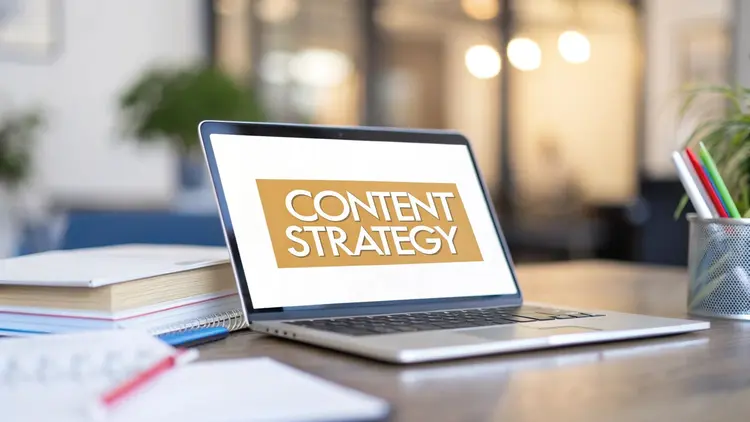Let’s be honest, most website content strategies don’t live up to the hype. They often end up a disorganized mix of blog posts, social media updates, and landing pages that just don’t resonate with the intended audience. This usually happens because there’s no strong, strategic foundation. Instead of working in harmony, these content pieces become isolated fragments of a puzzle that never comes together. A well-designed website content strategy template provides the necessary framework to avoid this common trap.
A solid website content strategy template serves as a blueprint for all your content activities. It makes sure that every piece of content you create, whether it’s a quick tweet or an in-depth blog post, aligns with your overall business objectives. This unified approach transforms scattered content efforts into a cohesive force that drives business results. Imagine trying to build a house without blueprints. You’d probably end up with a shaky structure that doesn’t meet your needs. The same principle applies to your content.
One of the biggest reasons content strategies fail is the lack of clear, measurable goals. If you haven’t defined your objectives, how will you know if you’ve succeeded? This often leads to wasted resources and a general sense of being lost. Many businesses also underestimate the importance of really understanding their target audience. Creating content without knowing who you’re creating it for is like trying to navigate a maze in the dark. You might eventually find your way out, but it’s going to be a long and frustrating journey. Developing detailed buyer personas is essential for a successful content strategy.
Creating a comprehensive website content strategy template is essential for businesses looking to improve their online presence. In fact, about 55% of businesses planned to increase their investment in content marketing in 2024 compared to the previous year. Content Marketing Statistics This trend highlights the growing recognition of content’s importance in digital marketing. However, to get a positive return on this investment, a clear strategic framework is essential.
The Hidden Costs of Unplanned Content
Besides the obvious wasted resources, unplanned content can negatively impact your business in other ways. It can dilute your brand messaging, confuse your audience, and even harm your credibility. It can also cause you to miss out on opportunities to engage potential customers and generate leads. This is why a structured approach, guided by a website content strategy template, is so important. Check out this helpful resource: How to Set Up a Work Recycling Program.

Building a Winning Content Strategy
Crafting a winning website content strategy involves several key elements. First, establish specific, measurable, achievable, relevant, and time-bound (SMART) goals. These goals will act as your compass, directing your content creation efforts. Next, develop detailed buyer personas to really understand your target audience’s needs, pain points, and motivations. This knowledge allows you to create content that genuinely connects with them. Finally, perform a thorough content audit to evaluate your existing content and identify areas for improvement. This helps you maximize the value of your current assets and ensures all new content contributes to your overall strategy. By incorporating these key elements, you can transform your content from a scattered collection of information into a powerful driver of business growth.
Setting Content Goals That Drive Business Results
Moving past vanity metrics like social media likes and shares is key to making a real impact on your business. Instead, focus on metrics that directly affect your bottom line, like leads, sales, and customer acquisition costs. Successful organizations understand this and carefully align their content goals with their revenue and customer acquisition targets. This makes sure every piece of content has a purpose in driving business growth.
Defining Smart Content Goals
A great way to develop focused content goals is the SMART methodology. SMART goals are Specific, Measurable, Achievable, Relevant, and Time-bound. For example, instead of a vague goal like “improve brand awareness,” a SMART goal would be “increase website traffic by 15% next quarter through targeted blog posts.” This clear goal gives your content creation a direction and allows for accurate tracking. Check out this helpful article: How to Increase Sales Through Content Marketing.
SMART goals also help your team stay on the same page. When everyone understands the goals and how their work contributes, it creates a sense of shared purpose and accountability. This collaborative environment leads to better content and improved results. It also makes it easier to show the value of your content strategy to stakeholders.
Selecting Key Performance Indicators (KPIs)
Choosing the right Key Performance Indicators (KPIs) is essential for measuring how well your content performs at each stage of the sales funnel. Different stages call for different KPIs. For example, during the awareness stage, you might track website traffic and social media reach. But during the conversion stage, you should focus on lead generation and sales.
This targeted approach helps you measure the right things at the right time, allowing you to see what’s working and what’s not in your content strategy. You can then make data-driven adjustments. For example, if your awareness stage content is doing great but your conversion rates are low, you might need to adjust your consideration and decision stage content.
Building Effective Reporting Dashboards
Creating useful reporting dashboards is crucial for showcasing the value of your content. These dashboards should visually represent your KPIs and provide clear insights into content performance. A good dashboard can quickly communicate the value of your content strategy to stakeholders, especially those focused on the bottom line.
These dashboards shouldn’t just be static reports, either. They should be dynamic tools that let you track progress, identify trends, and make smart decisions about future content. This continuous monitoring and optimization are essential for getting the most out of your content marketing efforts. A well-structured content strategy template helps businesses define clear goals, like increasing website traffic or generating leads, and connects these goals with measurable outcomes. For example, a SMART goal like “increasing website traffic by 25% over the next six months” offers clear guidance. Find more helpful statistics here.
Documenting Goals For Accountability
Documenting your content goals is essential for accountability. A website content strategy template provides a structure for recording objectives, KPIs, and target metrics. This documentation acts as a single source of truth for your team, ensuring everyone works towards the same goals.
This documented strategy also makes regular performance reviews easier and provides a framework for making data-driven adjustments. This process of planning, executing, measuring, and optimizing is key to a successful and lasting content strategy.

Creating Audience Personas That Actually Guide Decisions
Getting to know your audience goes way beyond basic demographics. Creating a website content strategy template is much more effective when you’re working with detailed audience personas. These personas dive deeper than simple demographics like age and location. They explore the motivations, pain points, and decision-making processes of your ideal customers. This takes the guesswork out of content creation and turns it into a precise, strategic process, ensuring your message resonates with the right people.
Research Methodologies for Uncovering Audience Insights
Effective personas are built on a foundation of solid research. This means analyzing website analytics to understand user behavior, conducting customer interviews to gather qualitative insights, and researching industry trends to identify broader patterns. Want to learn more about keyword research? Check out this helpful guide: How to Prioritize SEO Keywords in 4 Easy Steps. For example, by analyzing which blog posts get the most traffic, you can discover what topics truly resonate with your audience. Customer interviews provide valuable context, too, uncovering the why behind their actions.
Documenting Audience Pain Points and Content Preferences
It’s crucial to document audience insights systematically. This involves capturing their pain points, content preferences, and what motivates them to make a decision throughout their entire journey. A persona might reveal, for instance, that a customer prefers video content over written blog posts during the initial awareness stage. This means that prioritizing video creation for top-of-funnel content could significantly improve engagement.
Mapping Content Types to the Buyer’s Journey
Understanding how your audience interacts with content at each stage of the buyer’s journey is essential for a successful content strategy. This means mapping different content types to the awareness, consideration, and decision stages. Blog posts and infographics are great for raising awareness, while case studies and product demos are more suitable for the consideration stage. Finally, testimonials and free trials can be powerful tools during the decision stage. This targeted approach ensures your content effectively nurtures leads toward conversion.
From Persona Insights to Actionable Content Briefs
The real power of personas lies in how they inform content briefs. A well-crafted persona provides writers with clear direction, allowing them to tailor their message to a specific audience. This means providing details like preferred tone of voice, key messaging points, and the desired call to action.
Audience Persona Template Elements
To help you create a well-rounded persona, let’s take a look at the key elements. The table below provides a breakdown of each component, along with a description, example, and how it applies to your overall content strategy.
Audience Persona Template Elements: A comprehensive breakdown of the essential components needed to create effective audience personas for your content strategy
| Element | Description | Example | Strategy Application |
|---|---|---|---|
| Name/Role | A fictional name and job title that represents the persona. | “Marketing Mary,” Marketing Manager | Helps writers visualize the target audience. |
| Demographics | Basic demographic information such as age, location, and education level. | 35-45 years old, Urban, Bachelor’s Degree | Informs content format and distribution channels. |
| Goals | The persona’s professional and personal goals. | Increase website traffic, gain industry recognition | Ensures content aligns with audience aspirations. |
| Challenges | The obstacles the persona faces in achieving their goals. | Limited budget, lack of time | Helps identify relevant content topics and solutions. |
| Content Preferences | Preferred content formats and channels. | Blog posts, videos, social media | Guides content creation and distribution strategy. |
This table provides a clear framework for developing comprehensive audience personas. By incorporating these elements, you can gain a much deeper understanding of your target audience, which will help you create content that truly connects.

By incorporating these elements, your website content strategy template will be powered by a deep understanding of your audience, resulting in content that truly connects and converts. This persona-driven approach fosters a more focused and effective content strategy, leading to improved engagement and ultimately, better business outcomes.
Turning Content Audits Into Strategic Gold Mines
Most content audits unfortunately end up forgotten. But yours doesn’t have to share that fate! Smart content teams understand the power of a content audit and use it to create a real strategic advantage. This means thoroughly evaluating your existing content to discover hidden gems and identify underperforming pieces. This process helps you improve existing resources and create a strong plan for future content.
Quantitative and Qualitative Content Assessment
Content assessment involves two key approaches: quantitative and qualitative. Quantitative assessment uses analytics tools like Google Analytics to measure things like page views, bounce rate, and time on page. These numbers tell a story about what’s working with your audience and what’s not. For example, a high bounce rate might suggest that your content isn’t quite meeting user expectations.
Qualitative assessment, on the other hand, dives into the content itself. This involves evaluating things like relevance, accuracy, and overall quality. Does the content align with your brand voice? Does it resonate with your target audience’s needs? Think of it like reviewing a restaurant: quantitative data tells you how many people ate there, while qualitative feedback tells you about the actual quality of the food and service.
Competitive Analysis and Content Gap Identification
Finding those strategic advantages in your content audits also means looking at your competition. By examining what your competitors are doing well (and not so well!), you can identify content gaps in the market. These gaps represent opportunities to create content that your target audience is actively looking for but can’t find anywhere else. This helps you position your content as a valuable resource and sets you apart from the competition.
For example, if your competitors are primarily focused on blog posts, you might consider branching out into video content or interactive infographics. Addressing different learning styles can help you reach a wider audience and position your brand as an innovator.
Mapping Content to Customer Journeys and Prioritizing Initiatives
A website content strategy template helps you map existing content to different stages of the customer journey. This means understanding what content resonates with users at each step, from initial awareness to final conversion. Having the right content in the right place at the right time smoothly guides potential customers through the sales funnel.
Once you’ve mapped your content, you can prioritize content initiatives based on potential impact and the resources you have available. This involves evaluating which content gaps represent the best opportunities for growth and focusing your efforts accordingly. A targeted approach makes the most of your resources and ensures your content strategy supports your business goals.
Template for Content Mapping and Gap Analysis
This simple table can serve as a template to map your existing content and spot areas for improvement:
| Stage of Customer Journey | Current Content Assets | Content Gaps | Prioritized Initiatives |
|---|---|---|---|
| Awareness | Blog posts, social media updates | Lack of video content | Create a series of short, engaging videos |
| Consideration | Case studies, product demos | Limited customer testimonials | Gather and showcase customer success stories |
| Decision | Pricing page, FAQ section | No interactive tools | Develop a product configurator or cost calculator |

By using a website content strategy template and performing a content audit, you can transform your existing content from a static archive into a powerful engine for growth. This ensures that every piece of content you create contributes to your overall business objectives. And remember, content audits aren’t one-and-done activities. They should be an ongoing process, integrated into your content strategy for continuous improvement and lasting relevance.
Building a Content Calendar That Actually Works
Forget those rigid editorial calendars that end up gathering dust. Truly successful content teams build living, breathing planning documents. These documents strike a balance between strategic direction and the flexibility to adapt to the ever-changing online world. This means creating a Website Content Strategy Template that can evolve and grow right alongside your business. Think of it as a roadmap, not a strict itinerary. It guides your journey, but allows for detours and exploring new avenues as needed.
Practical Calendar Structures For Content Planning
There are several practical structures you can use, from simple spreadsheets to dedicated content calendar tools like Asana or Trello. A simple spreadsheet can work wonders for smaller teams, while larger organizations might benefit from more specialized tools. These tools often offer features like workflow management and collaboration capabilities. Choosing the right structure depends on your team’s size, your workflow, and how complex your content strategy is. For some helpful tips, check out this article on How to Master Your Content Calendar.
Content Categorization and Production Workflows
Establishing clear content categories helps keep everything strategically aligned. Think of categories as buckets for your content. You might have buckets for:
- Blog posts
- Social media updates
- Videos
- Email newsletters
This organization makes it easier to track your progress, identify any gaps in your content, and ensure that all content contributes to your overall strategy.
Efficient production workflows are also essential to prevent bottlenecks. Imagine an assembly line: each step in the process needs to flow smoothly into the next. This might involve:
- Establishing clear roles and responsibilities for each team member
- Using project management tools to track progress
- Implementing quality control checks at each stage
Team Responsibility and Accountability
Assigning clear responsibilities for each piece of content is key for driving accountability. When everyone knows their role, it promotes ownership and ensures tasks are completed efficiently. This could involve:
- Assigning specific team members to different content categories
- Establishing deadlines for each stage of the production process
- Holding regular check-in meetings to discuss progress and address any roadblocks
Maintaining Consistency While Adapting to Change
Consistency in publishing builds audience anticipation and strengthens your brand presence. However, it’s equally important to remain adaptable. Market conditions change, priorities shift, and new opportunities arise. A well-designed content calendar allows for adjustments without completely derailing your overall strategy. This balance between consistency and flexibility is essential for long-term content success. You can explore more about building a flexible template with this Website Content Strategy Template.
Scaling Your Content Strategy for Growth
The importance of scalability in a website content strategy template can’t be overstated. As your business grows and market conditions change, your content strategy must adapt to remain effective. This involves regularly reviewing your performance data and updating your strategy. This ongoing adaptation is crucial for maximizing your content’s impact and achieving your business objectives. By building a flexible and scalable content calendar, you can ensure your content remains relevant and continues to drive results, even as things change.
Creating Content That Truly Resonates
Creating content that performs well involves much more than just good writing. It demands a strategic approach, one that aligns perfectly with your overall website content strategy template. Leading brands understand this and use proven frameworks to consistently create engaging, conversion-driving content. This means thinking about everything from SEO best practices to brand voice and accessibility.
SEO Integration for Better Discoverability
SEO is essential for getting your content discovered. But keyword stuffing and other outdated SEO tactics can damage readability and hurt the user experience. This is where your website content strategy template comes in. A solid template will guide you in naturally incorporating SEO keywords within your content. This ensures your content is both search-engine friendly and a pleasure to read.
For instance, instead of forcing the keyword “website content strategy template” repeatedly into your text, focus on creating valuable content around related topics like content audits, persona development, and editorial calendars. These are all areas where a website content strategy template is extremely helpful. By exploring these topics thoroughly, you’ll naturally weave in the keyword while providing real value to your audience. This approach builds credibility and boosts search rankings.
Maintaining High Standards as You Scale
As your content output grows, keeping a consistent level of quality is key. Integrating quality control (QC) processes within your website content strategy template can be a real game-changer. Think about including QC checks like:
- Editorial reviews: These reviews ensure accuracy, clarity, and consistency with your brand voice.
- SEO checks: These verify correct keyword usage, meta descriptions, and image alt text.
- Accessibility checks: These confirm your content adheres to accessibility guidelines.
These steps help guarantee your content meets high standards, no matter how much you’re creating.
Creating Content With Lasting Value
Developing evergreen content as part of your website content strategy template helps you get the most long-term value from your content marketing efforts. Evergreen content focuses on timeless topics, avoiding trendy or time-sensitive information.
This requires a shift in mindset. Think about how each piece of content fits into your overall content library, not just as a one-off piece. Ask yourself: how can you create resources that continue attracting and engaging readers for months or even years to come?
Regularly updating and refreshing existing content is also essential. Make sure your content remains accurate and relevant to your audience. Think of your content like a garden – it needs regular care and attention to thrive. A well-designed website content strategy template helps you plan and execute these ongoing optimization efforts.
Defining Your Brand’s Unique Voice
Your brand voice is your distinct personality, expressed through words. Clear brand voice guidelines in your website content strategy template ensure consistency across all your content. These guidelines might address aspects like:
- Tone: Is your brand formal, informal, humorous, or serious?
- Language: Do you use technical language, simple language, or industry-specific jargon?
- Point of View: Do you write in the first person or third person?
A consistent brand voice strengthens your brand identity and builds trust with your audience. It ensures your content feels familiar and recognizable, no matter where they encounter it.
Prioritizing Accessibility in Your Content
Accessibility means that everyone, regardless of disability, can access and understand your content. Integrating accessible formatting practices into your website content strategy template makes a big difference. Consider:
- Descriptive alt text for images: Alt text allows screen readers to describe images to visually impaired users.
- Clear headings and subheadings: This improves navigation for everyone, particularly those using assistive technologies.
- Sufficient color contrast: This makes your content easier to read for users with low vision.
These practices not only make your content more inclusive but also improve SEO and the overall user experience.
Engaging Your Audience With Multimedia
Multimedia elements like images and videos can significantly boost engagement and improve message retention. They break up large chunks of text, making your content more visually appealing and digestible. Using different media formats can also cater to different learning styles, widening your audience reach.
Setting Content Creators Up for Success
Well-written content briefs, based on your website content strategy template, serve as blueprints for your content creators. These briefs ensure everyone’s on the same page, reduce revisions, and make content production more efficient. They also provide a handy reference point, helping teams create top-notch content that aligns with your overall strategy and objectives.
Content Type Effectiveness by Funnel Stage
To better understand which content formats perform best at different stages of the customer journey, let’s look at the following table.
| Content Type | Awareness Stage | Consideration Stage | Decision Stage | Key Metrics |
|---|---|---|---|---|
| Blog Posts | Attract organic traffic with informative, keyword-rich content | Provide in-depth analysis and comparisons of solutions | Offer case studies and customer testimonials | Website traffic, time on page, social shares |
| Infographics | Simplify complex information and capture attention on social media | Visually present benefits and features | Compare product options and highlight value proposition | Downloads, shares, backlinks |
| Videos | Build brand awareness and engage viewers emotionally | Demonstrate product usage and answer customer questions | Showcase customer success stories and product demos | Views, engagement, click-through rate |
| Ebooks & White Papers | Offer valuable, in-depth information in exchange for contact information | Provide expert insights and solutions to specific problems | Offer comprehensive guides and resources to aid decision-making | Lead generation, conversion rate |
This table highlights how different content types can be strategically used throughout the customer journey. Blog posts are great for initial awareness, while ebooks and white papers can help nurture leads in the consideration phase. Finally, customer testimonials and case studies can be very persuasive in the decision stage.
By applying these strategies, you can create content that performs well and maintains high quality. Remember, a well-defined website content strategy template is your key to developing content that truly makes a difference, engages readers, drives results, and helps you achieve your overall business goals.
Measuring What Truly Matters: Going Beyond Basic Website Analytics
Page views and bounce rates are helpful, giving you a quick peek into how your content is performing. But let’s be honest, they only scratch the surface. To really understand your content’s impact, you need to dig deeper and focus on metrics that drive strategic decisions. This means creating a website content strategy template that uses data to constantly improve your content and ensure it delivers real results.
This is the secret sauce that top-performing content teams use to stay ahead of the curve.
Choosing the Right Metrics for Your Goals
Think of your content’s purpose as a compass. Your metrics are the guideposts that keep you heading in the right direction. If your goal is to generate leads, simply tracking page views won’t cut it. Instead, you need to focus on metrics like conversion rates and lead form submissions. On the other hand, if brand awareness is your main objective, social media shares and reach become more important. A well-defined website content strategy template can help you define these goals upfront and choose the metrics that matter most. Learn more about measuring Core Web Vitals.
This focused approach helps you understand what’s working, what needs tweaking, and where to invest your resources for the biggest impact.
Creating Insight-Focused Dashboards
Data is powerful, but raw data can be overwhelming. Insight-focused dashboards take that raw data and transform it into easy-to-understand visuals of your key performance indicators (KPIs). These dashboards should highlight areas for improvement and show you how your content is trending over time.
For example, your dashboard could visually compare the conversion rates of different content types (blog posts, videos, infographics) at various stages of the buyer’s journey. This allows you to quickly see which formats are most effective at driving conversions, informing your future content creation.
Setting a Regular Review Schedule
Regularly checking in on your content performance is like getting a regular health check-up for your website. Including a clear review cadence within your website content strategy template keeps your strategy on track and aligned with your goals. Explore website content strategy templates further. These reviews should involve analyzing your dashboards, identifying areas for optimization, and adjusting your strategy accordingly. Think of this as a continuous feedback loop, constantly refining your content based on real-world performance. Regularly reviewing and updating ensures your content stays relevant, engaging, and effective in achieving those goals. A scalable content strategy lets you create more content, try new formats, and reach a wider audience without sacrificing quality.
Experimenting With Your Content and A/B Testing
Experimentation is the key to unlocking content success. A/B testing lets you compare different versions of your content to see which performs best. This might involve testing different headlines, calls to action, or even entire content formats. You could, for instance, try out two different headlines for the same blog post to see which one gets more clicks. Controlled rollouts offer another approach, gradually releasing new content to a small group to measure its effectiveness before launching it to everyone.
These methods provide valuable data, empowering you to make informed decisions. They also foster a culture of continuous improvement, always looking for ways to boost performance.
Documenting Your Learnings and Sharing Insights
Think of your content experiments as valuable lessons. Documenting the results of your A/B tests, controlled rollouts, and other experiments creates a knowledge base that informs future content decisions. This helps your team avoid repeating past mistakes. Sharing these insights across your organization ensures everyone benefits from what you’ve learned.
By implementing a robust measurement system, your website content strategy template becomes a dynamic tool for continuous improvement. This ensures your content stays relevant, engaging, and effective in achieving your business objectives.
Ready to simplify your content creation and boost your business? Lorelei Web offers resources and expert advice tailored to entrepreneurs, particularly those with ADD. We help you cut through distractions and focus on what matters, empowering you to achieve greater productivity and success. Visit Lorelei Web today to learn more.

Lorelei has been an online entrepreneur, marketer and writer since 2006. Her biggest passion is WordPress, which is why she switched to being a full-time blogger 20 years ago and hasn’t looked back since. With so many years of experience behind her, she is an expert in copywriting, SEO, marketing and business strategies.






